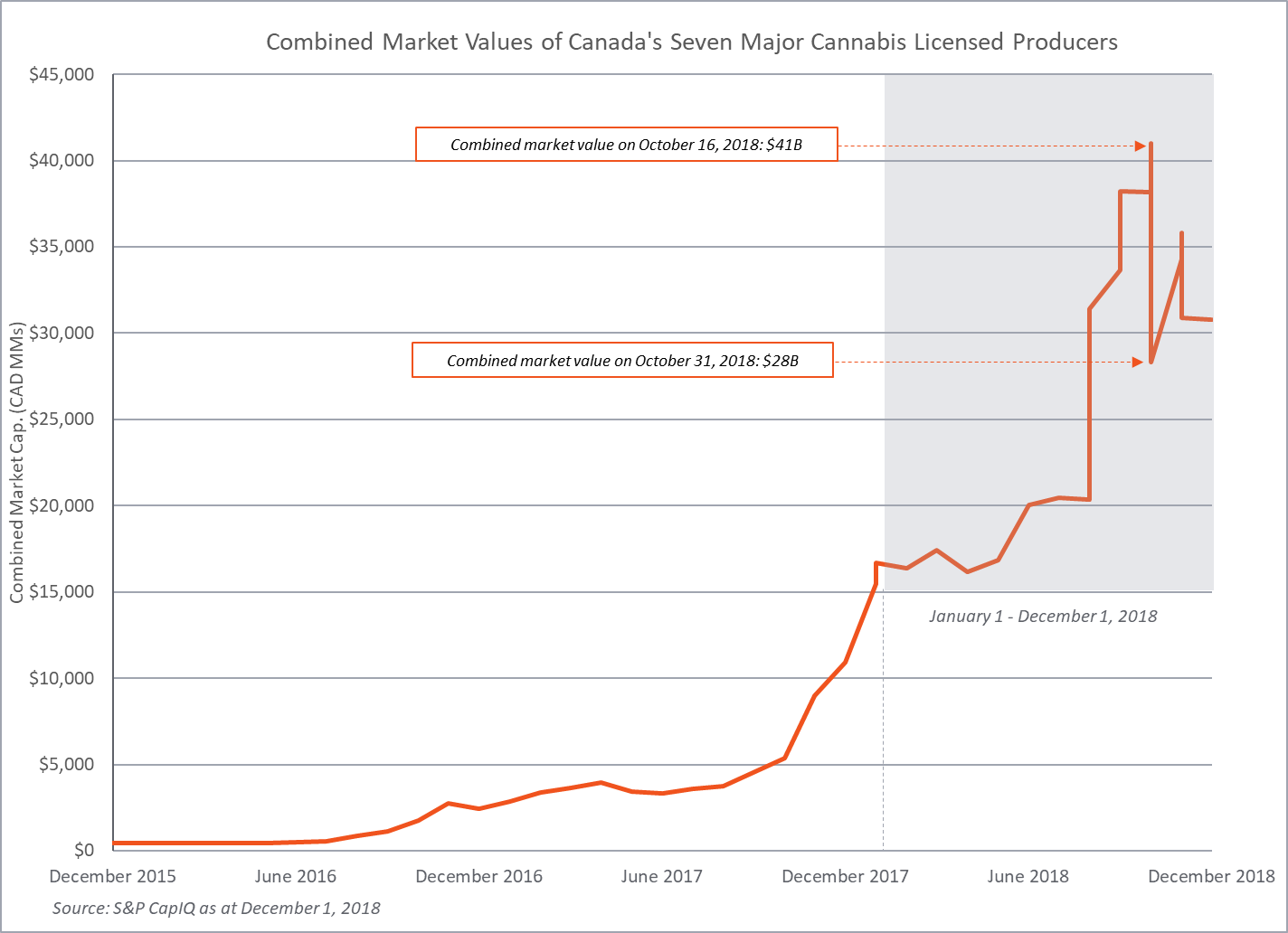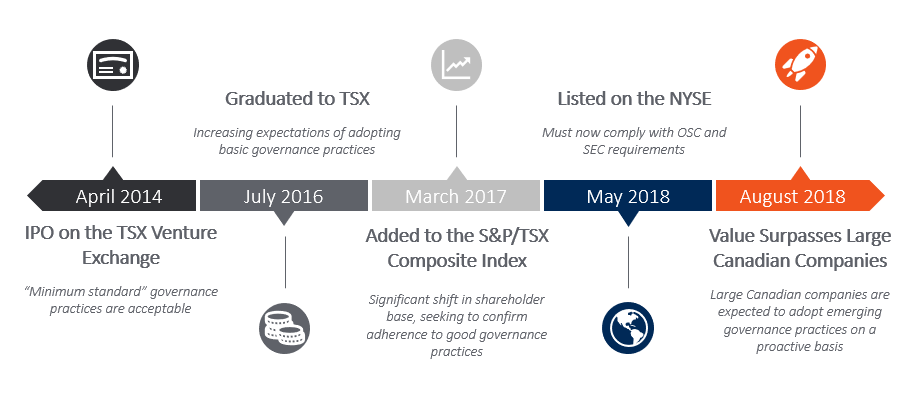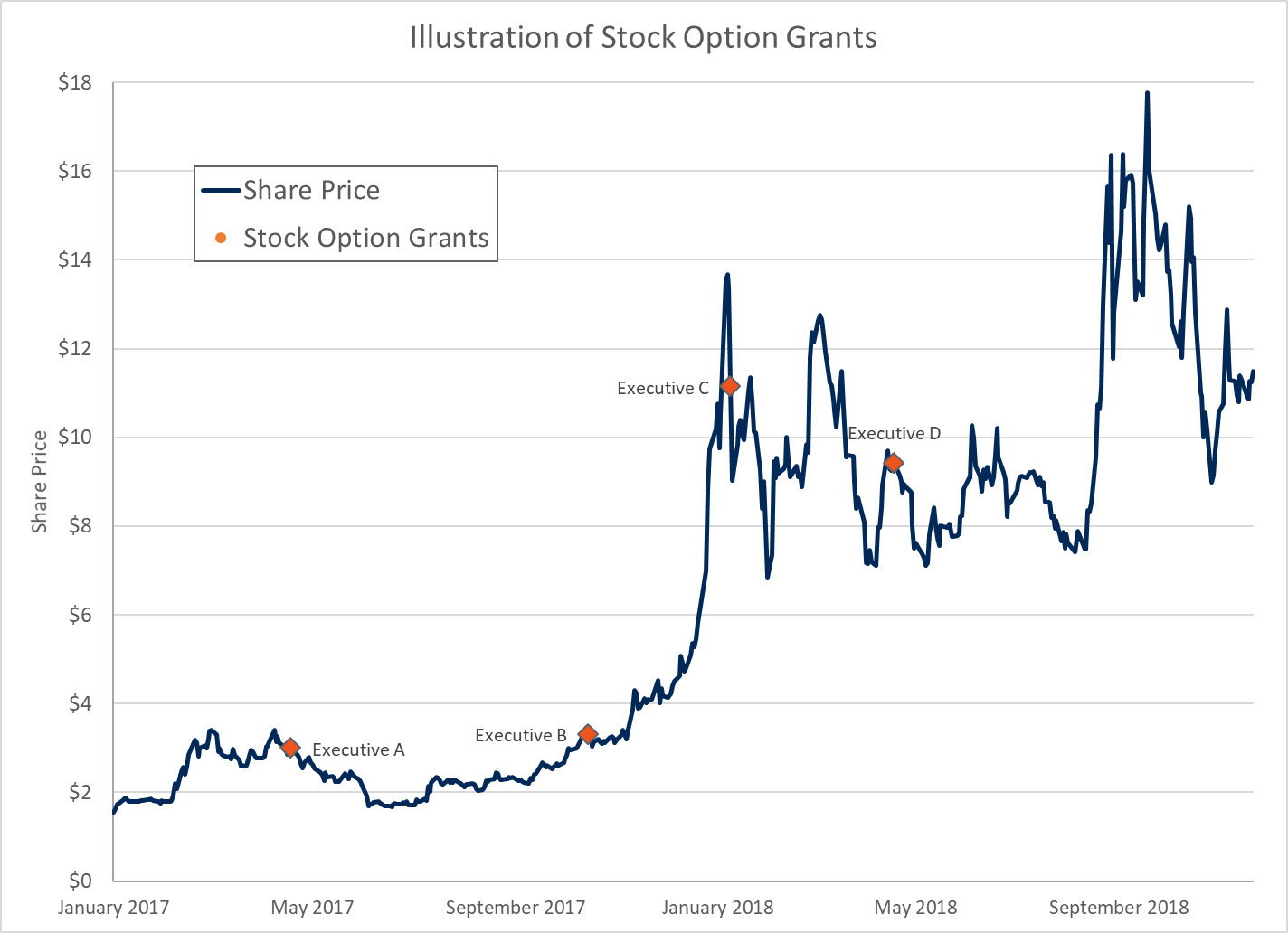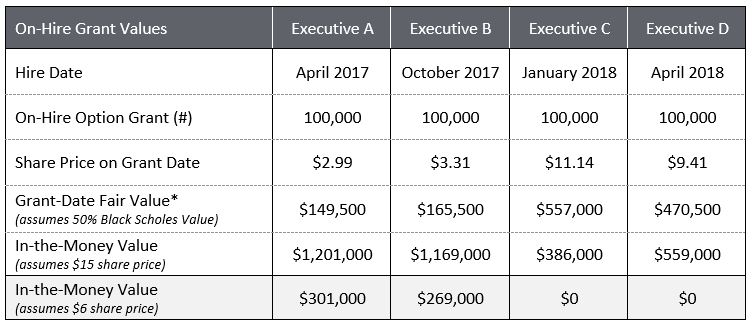On October 16, 2018, the day before recreational cannabis was legalized in Canada, the combined market values of Canada’s seven major licensed producers (“LPs”) was $41B, reflecting an average market capitalization to revenue ratio of ~200x1. In aggregate, this group of companies experienced a 675% increase in their market values over the one-year period leading up to legalization day.
However, two weeks after legalization, the combined market value for this set of cannabis companies had fallen over 30%.
The significant share price volatility for companies within the sector is only one factor contributing to the challenges within the industry. High multiples, rapid consolidation, legislative uncertainty, and the pace of innovation and international expansion are only some of the challenges facing the executives and directors leading this sector today. This article outlines some of the ways these challenges intersect with compensation and governance issues at Canadian cannabis companies, and some considerations for addressing these challenges. While this article has been drafted with cannabis companies in mind, many of these concept of are of equal relevance to emerging companies in high growth, disruptive industries.

Managing Governance Expectations following Rapid Growth
The Challenge
Larger (and typically more mature) companies tend to be subject to greater governance scrutiny than their smaller counterparts. Large Canadian companies are expected take proactive approaches to adopting emerging governance standards, while being subject to increased focus from institutional shareholders, proxy advisors (e.g., ISS and Glass Lewis), and the media or other industry observers. Managing these increasing expectations can prove challenging for cannabis companies and their boards as they move very rapidly through these governance “stages,” while also navigating the challenging terrain of a high-growth company in an emerging industry.
An example of this rapid progression can be observed in Canada’s largest cannabis company, Canopy Growth Corporation, whose market capitalization surpassed that of many of Canada’s most well-known companies in late August 2018 (e.g., Canadian Tire, Metro, and Dollarama) following a significant investment from Constellation Brands.

As shown above, Canopy Growth progressed from an IPO on the TSX Venture Exchange to being a significant Canadian issuer in just over four years. While we are not commenting on Canopy Growth’s governance approach specifically, this rate of growth could reasonably cause any company that has experienced a similar trajectory to struggle to keep up with evolving governance expectations.
Considerations for Human Resources & Compensation Committees
Some degree of governance “strain” will always be present for companies that undergo the significant growth that the cannabis sector has experienced. However, to be mindful of these increasing governance expectations, boards could consider:
- Undertaking deliberate and frequent assessments of governance expectations for the company, incorporating feedback received from shareholders, proxy advisors, and other stakeholders
- Keeping abreast of the governance practices adopted by other companies in the cannabis sector and the broader market
- Developing a roadmap for adopting basic or emerging governance practices (as appropriate, based on stage of development, shareholder / stakeholder considerations, etc.)
Setting Performance Targets in an Uncertain Market
The Challenge
In any industry, boards and management teams will at times struggle with forecasting results and setting performance targets due to external factors beyond their control. This challenge is particularly evident in the cannabis industry, where legislative and regulatory uncertainty (at the federal and provincial level), rapid consolidation, and the possibility of market corrections all pose challenges in setting forward-looking targets.
These challenges intersect with compensation matters in the determination of forward performance targets in annual or multi-year incentive programs. How can companies incorporate performance-linked incentive plans (which are widely accepted as being preferred from a governance perspective) into their compensation frameworks in the context of such uncertainty?
Considerations for Human Resources & Compensation Committees
While the inherent uncertainty in the Canadian cannabis industry is unavoidable, careful consideration of the design of incentive programs can help address some of the issues referred to above; consider the following:
- Including a mix of formal quantitative financial goals (e.g., revenue or earnings targets), operational objectives (e.g., yields, production costs), and strategic milestones (e.g., achieving licensing, expansion into a certain market, strategic partnerships, etc.)
- Allows for a more holistic approach to evaluating company performance in a given year
- Progress against strategic milestones can be challenging to objectively measure; where possible, companies should incorporate quantitative and specific milestones into the measurement of these metrics
- Debating and evaluating the treatment of significant acquisitions at the Human Resources & Compensation Committee or Board level (e.g., should earnings targets be adjusted upwards to incorporate the impact of any acquired companies throughout the year? How to treat one-time acquisition-related costs?)
- Retaining the ability for the Human Resources & Compensation Committee to exercise discretion (upwards or downwards) on the annual bonus score and payouts each year, based on its informed judgement and assessment of any unusual circumstances
- Reviewing and re-evaluating incentive plan structures and metrics more frequently (annually? biennially?) than one would generally expect in more “stable” industries
- E.g., when to shift from revenues- to earnings-based metrics? Reassess the relative weights for financial vs. operational metrics? Incorporate business segment specific results for key divisions?
- E.g., when to shift from revenues- to earnings-based metrics? Reassess the relative weights for financial vs. operational metrics? Incorporate business segment specific results for key divisions?
Share Price Volatility and the impact on Equity-Based Compensation
The Challenge
There may be a sense in the Canadian cannabis industry that there may be “easy money” to be made, and that everyone is “getting rich” from their highly valuable stock options. While this is may be true in some cases, it may not be a realistic expectation for executives who have joined companies after the share price has already appreciated significantly. Nonetheless, this perception from executives can cause distraction and may at times highlight retention issues.
This challenge is exacerbated by the counterintuitive nature of valuing stock option for disclosure purposes in a company’s annual proxy circular. The summary compensation table requires that any stock option awards are disclosed on a “grant-date fair value” basis – namely, the share price upon grant date, with a Black-Scholes (or other option valuation methodology) discount applied. As it is a function of share price, the grant-date fair value of a stock option award, when disclosed in a proxy circular, is greater when the stock price is higher. However, this same stock option grant would be viewed as being less valuable to an executive, as the “in-the-money value” would ultimately be lower due to the higher strike price. Specifically, the challenge is that the option valuation methodology assumes that the underlying shares are priced efficiently, and, theoretically, having a stock option on a $10 share should provide a much larger return than on a $1 share. However, for high-growth companies in disruptive industries, the opposite is true: an employee receiving an option on a $10 share has missed the $9 of price appreciation that an employee who received options on a $1 share.
Adding to this challenge is the stock option granting approach taken by most early-stage companies, including those in the cannabis industry. Many early-stage companies provide their executive team with option grants either based on an overall pool (e.g., our stock option pool is 10% of the outstanding shares, and Executive A will receive 15% of this pool) or as a fixed number of units (e.g., all CEO direct-reports will receive 100,000 stock options this year). This is a practical approach for early-stage companies. However, the volatility and rapid pace of growth in the cannabis industry can present challenges to this approach, namely:
- Unintended disclosure consequences: when granting equity awards without considering the grant-date fair value for disclosure purposes, it is possible to end up with values in the summary compensation table that are significantly higher than intended, which could result in scrutiny from shareholders, proxy advisors, or the media (particularly with the focus on the industry as a whole)
- Inequity between recipients: consider the following illustration (below) of four executives who receive stock option grants at different times over several months, with significantly different outcomes
The chart and table below demonstrate these challenges by illustrating four “on hire” option grants at a notional Canadian cannabis company:


*disclosed in the summary compensation table
Considerations for Human Resources & Compensation Committees
The approach of granting equity awards as a percent of a pool or as a fixed number of units is a practical and reasonable approach for early-stage companies that are in the process of bringing in key executives who will be responsible for significant near-term growth of the company. However, as companies mature, there is often a need to mitigate some of the inherent challenges in using equity-based compensation in the context of a highly volatile share price. Some best practices for equity grants at relatively more “mature” companies are as follows:
- Size equity awards based on a pre-determined dollar value; the number of units granted would be a function of this desired grant value
- These grant values should be determined in the context of an executive’s total compensation package and informed by market data
- Develop a formal annual equity granting process, whereby all executives receive grants on the same day and at the same share price
- This would help align the executive team and address the challenge of having inconsistent in-the-money values across the team
- Recognize that this may not always be practical in the context of mid-year hires, who often receive equity grants as sign-on awards
- Ensure dilution, burn rate, and overall equity pool implications are considered when making stock option grants
- Stock options are not “free” and can ultimately prove to be quite dilutive to a company
- Maintain some degree of “dry powder” within the equity pool to allow for grants to be made to new hires, etc.
- Over time, evolve the compensation framework to incorporate full value share units (e.g., restricted share units or “RSUs” or performance share units or “PSUs”)
- The grant-date fair value of these awards are more transparent as they are equivalent to the value of one share each (particularly RSUs, which do not have performance conditions)
- Incorporating full value share units into compensation frameworks can serve to somewhat mitigate the risk of an executive (or full executive team) having their entire stock option awards being “out of the money” due to a volatile share price
- Further, these are generally viewed as being more “shareholder-friendly,” and more mature companies typically evolve their programs to increase the proportion of RSUs and / or PSUs in the long-term incentive mix, while decreasing the use of stock options
Other Topics of Interest
Conclusion
The great economic and social experiment of cannabis legalization in Canada has only just begun, and it remains to be seen which industry players and strategies will prove to be the most successful. While no substitute for strategic innovation and execution, a proactive approach to establishing sound compensation and governance practices can reduce distractions and allow a company’s key decision makers to focus on what is the most important to the success of the business.
1 (n = 6), excludes one pre-revenue company; per S&P CapIQ